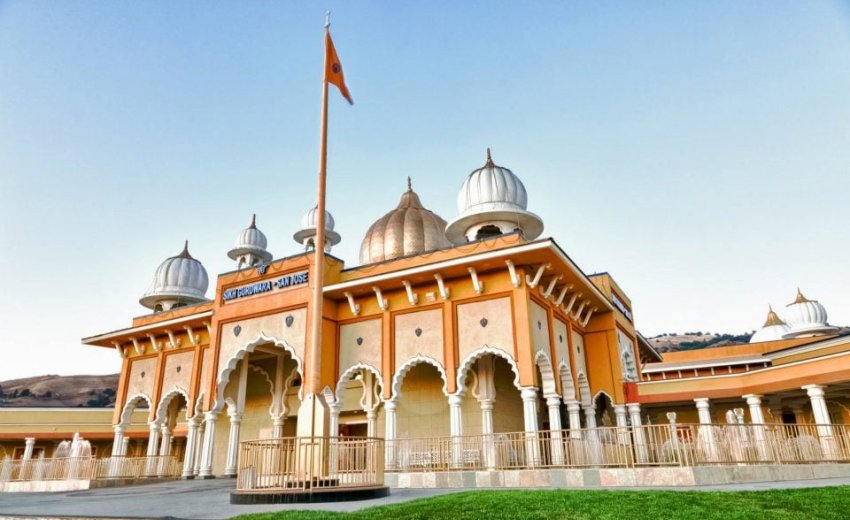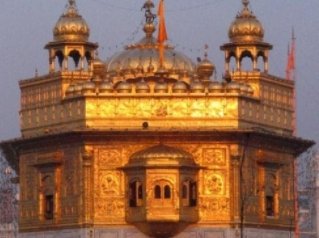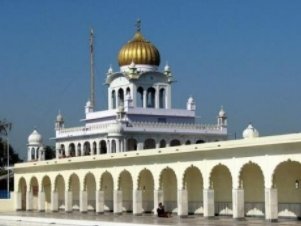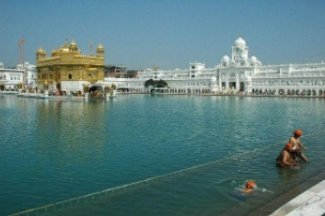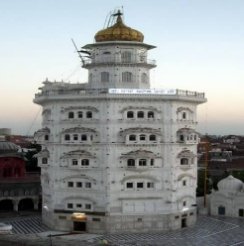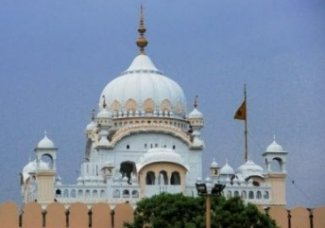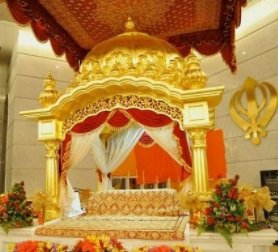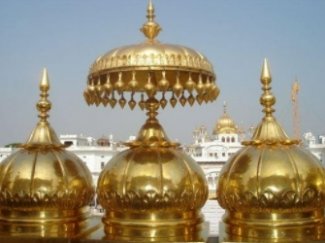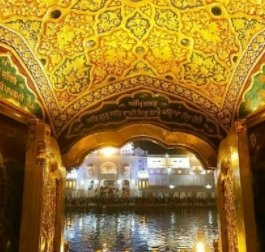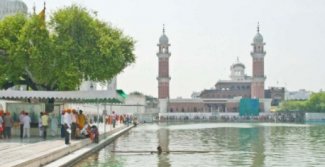Growing up in New Delhi, India, I do not think I can recall a time when I did not know of the Gurudwara. There was one on the same block as my home—where I lived for the first eighteen years of my life. Its crystal-white dome, the echoes of the evening Rehras Sahib and the taste of the fresh Kadha Prasad are memories I associate with home and peace.
Since then, I have not been so lucky to have one so close to where I lived, but I have found many worldwide. Each is different, yet so similar. It is hard to define gurudwaras in one big umbrella. They vary stylistically so often, from the more traditional structures from 19th century Punjab to basements in brownstones in the West. Different in form but same in function and character.
Gurudwaras around the world are not characteristically defined like churches or mosques with distinct architectural features like the Gothic buttress or the Ogee arch, which stylistically distinguish and better define such structures. Instead, they are defined by function—the langar, the community culture and most of all, the open door. As an architect, I always saw them as civic spaces, as spaces where one is free to gather and assemble regardless of where one comes from. But this definition is incomplete at best. The gurudwara is, first and foremost, a place of worship. Therein lies a question then.
To answer this underlying question and expand my understanding of the gurudwara, I reached out to Dr. Devinder Pal Singh, a renowned academic and the Director at the Center for Understanding Sikhism in Mississauga, Canada. His research on Sikh Studies and culture is unparalleled. What follows is our conversation in the form of an interview wherein he discusses the complexities and simplicities of the Gurudwara and its role in Sikhism, North America and the world at large.
Ekam Singh: What is the role of the gurudwara for the Sikh community?
Dr. Singh: Gurdwaras have crucial importance to the religious, social, and political life of the Sikhs. They have performed a critical part in developing the Sikh religious traditions and shaping Sikh history. Since its inception, the role of a gurudwara (initially called Dharamsal) for the Sikh community has been manifold. First, it is where the Sikhs assemble for worship and prayer. There are three main functions carried out in all public Gurdwaras. One is Kirtan - the singing of hymns from the Guru Granth Sahib; another is Katha - the reading of the Guru Granth Sahib and explanations. The third primary function is Langar (free community kitchen) for all visitors.
Along with these primary functions, Gurdwaras around the world also serve the Sikh community in many other ways including, libraries of Sikh literature, museums of historical artifacts, schools to teach children Gurmukhi, the script of the Sikh scriptures, training centers for martial arts (e.g., Gatka, Judo, Karate etc.), and charitable works. In addition, various ceremonies (e. g., naming of a child, marriage, funeral etc.) are performed at Gurudwaras. Finally, gurudwaras also act as assembly places for the Sikhs to reflect upon and take appropriate decisions about the Community’s critical social, religious, and political issues.
Ekam Singh: What is the role of the gurudwara for communities outside Sikhism?
Dr. Singh: People of all faiths are welcome at a gurudwara. Initially, a gurudwara was a place where Sikhs could go to hear the human Gurus speak. Generally, there are four doors for the entrance to the sanctum sanctorum in a Gurdwara. It suggests that everyone is welcome, regardless of one’s status, occupation, gender, religion, caste, color or creed.
At the time of community and national emergency, Gurudwaras act as shelter/refuge for the people. For instance, during the devastating fire that almost engulfed the town of Fort McMurray, Alberta, in 2016, the Sikh community came together to collect 1 million dollars in food and clothing for those affected by the fires. In addition, nine semi-trucks full of food and clothing were sent to the victims by the gurdwara leaders in the spirit of Seva (selfless voluntary service) and Sarbat da Bhalla (well-being of all people).
Another way that the Sikhs have manifested their service ethic to the society is through the tradition of Langar (the community kitchen) in the Gurdwara, where free warm meals are served to all visitors, without any distinction of religion, race, ethnicity, gender, or economic status. Currently, the Sikhs have taken the Langar outside of the gurudwaras. Now, they serve meals in other venues, even at the places where people are suffering from natural and manmade disasters. For instance, UNITED SIKHS and the Yangon Sikh Gurdwara served Langar to thousands of Myanmar cyclone survivors in 2008. During 2010, United Sikhs' volunteers served Langar to survivors of the earthquake in Haiti. The Sikhs also served Langar to flood-hit victims in Kerala (2018), Chennai, Tamil Nadu (2018), Uttara Khand (2018), Assam (2019), and Bihar (2021) in India.
Through its Langar Aid project, Khalsa Aid International, UK serves the homeless, vulnerable, and those struggling with poverty in the UK. They also work internationally to provide humanitarian aid in disaster and war zones. For instance, in 2015, it set up a free bakery near the war zone to feed fleeing Syrians.
The inclusiveness and Oneness of all humankind are much renowned Sikh doctrines. Sikhs took these concepts beyond the Sikh community by helping and serving others without discrimination. Consequently, now even Muslims, Hindus, Christians, and many others donate towards Langar, and do it because this is what Oneness looked like and felt like.
Ekam Singh: How do you think Gurudwaras responded to the pandemic?
Dr. Singh: It is difficult to outline all activities taken up by the worldwide Gurudwaras to combat the Corona pandemic. But I hope a few would suffice. For instance, a few media reports are as follows:
- In March 2020, when the New York mayor's office approached the Sikh Center in New York, USA, for assistance, the Sikh Center handed out tens of thousands of food packages to various federal agencies in the region for distribution among the needy. Besides, during the pandemic, Sikh volunteers delivered thousands of meals to vulnerable populations, including homebound seniors and those unable to afford meals, in New York, California and Washington state, USA.
- Gurudwaras in Melbourne and Adelaide cities of Australia started a free tiffin service for those in isolation during the pandemic. The needy persons can even order food by telephone, which is delivered to their doorstep by Sikh volunteers (March 2020).
- In Canada, many gurudwaras launched a food-delivery service for free, with the help of local restaurants and Sikh families to help the needy persons (May 2020).
- In the UK, the Midland Langar Sewa Society served hot meals to the homeless in Birmingham, and its teams reached out to those who had isolated themselves, throughout the UK. Many other gurudwaras in countries like New Zealand, South Africa, Germany, etc., are also involved in similar exercises.
-
Various Gurudwaras of the Lucknow, Mahanagar, Aishbagh, Gomti Nagar and Alambagh cities in Uttar Pradesh, India, had launched 'oxygen langar' for patients requiring oxygen during home quarantine. In addition, Lucknow Gurudwara Management Committee provided two hearses for taking covid positive bodies to the cremation ground free of cost. This service was for free and for all. Moreover, the committee ensured that the poor utilized its services more (May 2021).
- Several Gurudwaras worldwide opened their door to establish Covid 19 vaccination center at their premises to provide easy access to the service to the community and others. For instance, the vaccine clinic at Surrey Sikh temple in British Columbia, Canada, successfully delivered vaccination services to all people (May 2021).
- As another example, I would like to add that during the first wave of Covid in India, Bangla Sahib Gurdwara, New Delhi, India fed 75,000 people every day. At the time of the second wave of corona pandemic, Guru Harkishan Institute of Medical Sciences and Research, located on Bangla Sahib's premises, started a free-of-cost 100-bed dialysis center for all without any consideration of caste, colour, creed or class (July 2021).
Ekam Singh: In your personal life, what role does the gurudwara play?
Dr. Singh: In my personal life, gurudwara plays a crucial role as a beacon of light. It provides help in rejuvenating my faith, providing temporal and spiritual guidance, and a feeling of community fellowship. Gurdwara also plays a crucial role in linking me to an extraordinary Sikh heritage, full of selfless service and sacrifice to humanity. Several of my life affairs (naming ceremony of my children, marriage, funeral, prayer, thanksgiving ceremonies etc. of my family) have been settled at the gurudwara.
Ekam Singh: Historically, how do you think the gurudwara has evolved in the North American context?
Dr. Singh: As of 2020, there are 24 countries in North America. Among them, the United States is the biggest one by population while Canada is the largest country by area. Areawide, the four main countries of North America are the USA, Canada, Mexico, and Greenland. The Sikh population is about 0.7 million in the USA, 0.5 million in Canada, and only 8000 in Mexico. In contrast, no figures are available for the Sikh population in Greenland.
The first Sikh community entered the United States via the West Coast during the 1890s. At present, there are more than 300 gurdwaras in the United States, situated in big cities like Los Angeles and small rural farming towns alike. Gurdwara Sahib Stockton, located in Stockton, California, is renowned for being the first gurdwara in the United States. The Pacific Coast Khalsa Diwan Society founded the gurdwara in 1912. It was also called 'Gadari Babeyan da Gurdwara' (the gurdwara founded by the members of the Hindustan Gadar Party.)
The first Sikh immigrants came to Canada in 1904 and established themselves in British Columbia. They created the Vancouver Khalsa Diwan Society in 1906. Under its leadership, Sikhs built their first Gurdwara in 1908 in the city of Golden, British Columbia, Canada. By 1920, several other gurdwaras had been established in various cities, e.g., Victoria, New Westminster, Golden, Abbotsford, Nanaimo, Fraser Mills and Paldi. An independent, elected executive board controlled each. At present, there are over 150 Gurudwaras in Canada, managed by local management committees.
There are about 8000 Sikhs in Mexico and only one gurdwara in Mexico City. In 1976, S. Arjan Singh, a granthi from India, came to Mexico City to look after it. There is almost no Sikh population in Greenland, so there is no Gurudwara.
From the architectural point of view, Gurdwaras in USA and Canada have evolved from a simple single room structure to magnificent structures with elaborate detailing and decoration. In addition, most cities now have several gurdwaras, each reflecting slightly different religious views, social or political opinions, or caste backgrounds. Sikhs now have access to a complete set of public observances through them. For most communities, Sunday services are available there, followed by langar provided by members of the Sangat (congregation).
Worship in the gurdwara includes reading scriptures, meditation, prayer, and singing hymns. Anyone who follows the conventions for entering a gurdwara can participate and avail of the services. Though a few Canadian congregations have integrated chairs and tables, but worshippers mostly sit on carpets. In addition, various Gurpurabs and traditional Sikh calendrical celebrations, e.g., Vaisakhi etc., are celebrated in Gurdwaras. Sikhism gives particular importance to family life, philanthropy, service and defence of the faith. Traditionally, service has been expounded as service to the religion and the community. However, this service perception is slowly incorporating a broader perspective of North American social issues. However, one component of the traditional Gurudwara system missing in North America Gurudwaras is the lack of sarovars (water tanks) in their proximity and thereby they fail to care for marine life and Nature.
Many Sikhs wish to teach their children their culture and religion. So, many Gurdwaras offer classes teaching religious precepts and Punjabi language to children; some second-generation Sikhs speak Punjabi but need to be formally taught the Gurmukhi script in order to read Sri Guru Granth Sahib. In addition, national and regional conferences to discuss Sikh issues are often held in various cities, and informal contacts between regional Gurdwara managements are usually maintained. However, the primary organizational basis of North American Sikhism is the local gurdwara association, and some North American Sikhs also maintain solid religious ties with India.
Since the last many years, there have been several attempts to establish an integrated national Sikh religious organization within Canada and USA; however, this aim has not been achieved yet. Nevertheless, with its strong community institutions, group consciousness, and ready adaptation to new technologies, Sikhism has grown in North America, especially Canada and the USA, despite the pressures of assimilation and secularization.
Ekam Singh: How do you think the building itself or the architecture speaks to you as someone who studies Sikhism?
Dr. Singh: As a Sikh, Gurdwara building or architecture, for instance, Harmandir Sahib, Keshgarh Sahib and Anandgarh Sahib etc., speaks to me on two levels, i.e., Temporal and Spiritual.
On the temporal level, massive columns, portals, inner structures, bukharchas (3 or 4 paneled projecting windows in a row) on the projecting base, and chhatns (kiosks) on the parapet remind me of Rajput architecture. But, on the other hand, the dome, arches, minarets, and underground cellars resemble Mughal architectural style. However, gurdwaras also display the innately eclectic nature of their architectural design. They possess several distinct features and bring forward an identifiable picture of a style that can indeed be called Sikh Architecture.
For instance, compared to Hindu temples, Gurudwaras are more spacious, with the addition of adjoining divan asthan (assembly halls), where necessary, e.g., Manji Sahib Diwan Hall in Hari Mandir Sahib. Moreover, often, they have an entrance from all four sides. They are also not oriented to any particular direction like the Muslim mosques. Guru ka Langar (community kitchen and dining hall) is an essential adjunct to a gurdwara, and most gurdwaras have sarovars (bathing tanks) in the vicinity. A gurdwara is recognizable from afar by the Nishan sahib, the Sikh pennant in yellow or blue flying atop a high flag post. Gurdwaras are often devoid of any sculptured images in or around them.
Basically, any gurdwara's building need not conform to any specific architectural design. The only essential and established requirement is the installation of the Guru Granth Sahib in a building under a canopy, on a higher platform, relative to the floor, where the devotees sit. But in time, many gurdwaras came to have structures of a particular design imitating the pattern of Harmandar Sahib, Amritsar.
Based on their plan form, Gurudwara buildings can be classified into four primary shapes: the rectangular, the square, the cruciform and the octagonal. However, cruciform is rarely used. One specific example of cruciform structure is Gurdwara Nanakjhira at Bidar in Karnataka, India. On the other hand, the famous Gurdwara Baba Atal in Amritsar is octagonal. Many gurdwaras have an octagonal sanctum sanctorum within their rectangular or square hall. An open or covered circumambulate passage usually runs around the sanctum.
Gurdwaras buildings vary in height too. These can be one to nine storeys high. However, these buildings are often topped by a dome. Moreover, many gurdwaras have basements below the ground floor, for instance, Bhora Sahib at Anandpur Sahib and Gurudwara Guru Tegh Bahadur Ji, near Harmandir Sahib at Amritsar.
A recurrent element of gurdwara design is the preferred use of two-storey height with an all-around gallery at mid-height, leaving the center of the ground floor covered only by the top roof or the dome. As a rule, the dome is the crowning feature of a gurdwara. Even flat-roofed, rectangular gurudwara buildings often have a decorative dome over the spot where Guru Granth Sahib is installed.
Many times, a small single-room shrine is topped by palki, a palanquin-like roof derived from the Bengal style of architecture. Generally, the dome is ribbed or fluted. Various dome shapes often mark our shrines. These shapes include hemispherical, oblong, conical or three-quarters of a sphere. The more frequently used dome shape is spherical. The dome starts from a floral base and has an inverted lotus symbol top from which rises the kalash (the ornate finial).
Gurdwaras domes are usually painted in white or many times in gold. Domes of some important gurdwaras are often covered with gold-plated copper sheets. In contrast, domes of many other gurudwaras are lined with marble slabs or white or colored porcelain pieces.
Besides the large central dome, there are often four other cupolas, one at each corner and several small solid domes embellishing the parapet. An ornate finial, the Kalash, invariably tops the dome. It shoots up in the form of a cylindrical construction, usually with some spheroids and concentric discs culminating in a small canopy with pendants hanging at the outer rim. The Kalash is traditionally made of brass or gilded copper. However, recently the use of steel or gilded khanda (double-edged sword) as pinnacle has come into vogue.
A Gurudwara's interior is often beautified using gachch or stucco work, tuknor fixing of mirror pieces, jaratkari or inlay work, mohrakashi or filigree, latticework or stone grills, and fresco painting. These techniques produce beautiful designs and friezes based on vine, plant, flower, bird, and animal motifs. Marvelous examples of such work can be seen in the Harmandir Sahib. The most significant number of frescoes have been painted on the first-floor walls of Baba Atal. It is important to note that Gurdwaras are not ornamented with depictions of God. They don't have ritualistic objects inside like the kind one may find in Catholic cathedrals or Jewish synagogues. The Guru Granth Sahib, the home of the eternal guru, is all that Sikhs require.
Each Gurdwara contains a deorhi (entrance gateway) too. The deorhi is usually an impressive structure and large, and it often serves as an office. A unique aspect of Sikh architecture is the contribution and participation of the common persons in raising or building a gurudwara.
On the spiritual level, a Gurdwara is where I can join a holy congregation (Sadh Sangat) in communal worship. The four doors of the Sanctum Sanctorum at Harmandir Sahib, Amritsar and similarly of many Gurudwaras worldwide make me aware that people from all directions (North, South, East, and West) and all the Varnas of Hinduism (Brahmin, Kshatriyas, Vaish and Shudar) are equally welcome at Gurudwaras. It helps me realize the importance of the Sikh values of universal fellowship and equality.
Another aspect of spiritual significance for me is the depiction of Lotus symbolism in Sikh art and architecture. For example, Harmandir Sahib floating in the middle of a pool is the personification of the lotus flower. A fully bloomed and open lotus flower represents full enlightenment and self-awareness. As mentioned earlier, most of the Gurdwaras are adorned by domes.
A dome symbolizes an unopened bud of a lotus flower. The unopened bud is symbolic of a folded soul that can unfold and open itself to the divine truth. Even the architecture of the buildings in and around Harmandir Sahib and the tops of the pillars in the parikrama (walkway) around the Harmandir Sahib have symbolic lotus leaves decorating them. The lotus flower's opening petals symbolize the potential for the soul to expand and blossom into beauty and divinity. They represent the surrender of the mind to the power above. They embody openness and submissiveness even as the roots are mired in the muddy waters of worldliness and sin.
Another aspect of Gurudwara that rejuvenates my spiritual life is the Pangat and Langar traditions in Gurudwara. Langar hall is a regular part of a Gurudwara building. The activities at langar hall promote the Sikh values of Pangat (sitting at the same level in a row), selfless voluntary service, Sangat (universal fellowship), and equality for all.
Ekam Singh: Which is your favorite gurudwara in New York or North America?
Dr. Singh: In my opinion, all gurudwaras, wherever the teachings of Sri Guru Granth Sahib are preached, are equally important. However, some gurudwaras are more famous due to their historical association with the life events and activities of Sikh Gurus and Sikh martyrs. I do not have a personal preference for any Gurudwara in New York or North America. The essential criteria for deciding which gurudwara I should visit are the availability of quality spiritual and temporal services at a Gurudwara, its easy accessibility, and its nearness to my location.
Ekam Singh: How does the gurudwara embody Sikh values?
Dr. Singh: Gurdwaras embodies the Sikh values of Universal fellowship, equality for all and selfless service to others through its various institutions such as Sangat (Holy congregation), Pangat (sitting at a level in a row or a group) and Langar (community kitchen). Seva (Selfless Service) is central to the Sikh faith. It is part of Guru Nanak's central message. The contemporary Sikh community is keeping this tradition alive by helping people at disaster sites worldwide and serving Langar in the scores of gurudwaras located worldwide. Through the pandemic, Sikhs have been seen to host oxygen langar, feed millions of migrants, distribute food through deliveries, drive-through set-ups and Seva trucks (July 2021).
From the architectural point of view, the four doors of Sanctum Sanctorum at Harmandir Sahib, Amritsar and many Gurudwaras worldwide signify that people from all directions, all Varnas of Hinduism, all races, and all nations are welcome at Gurudwaras. Thereby the Sikh value of equality for all is embodied.
The Sikh Gurus showed the world how to appreciate the interdependence of living beings and their environment. They also displayed the way to nurture this interrelationship. All their constructions adhered to this principle. Thereby, they built many Gurudwaras surrounded by large pools, which supported marine life, especially fish. It was/is a sign of living in harmony with the environment rather than in conflict. The seventh Sikh Guru, Guru Har Rai developed Kiratpur Sahib as a town of parks and gardens. Kiratpur, being located on the banks of a tributary of the Sutlej River, he planted flowers and fruit-bearing trees all over the area. It created a healthful environment, attracting beautiful birds to the town and turning it into an idyllic place to live in.
Though respect and love for the environment and Nature are common to almost all religions, the naming of sacred shrines (Gurdwaras) after trees is exclusive to the Sikh religion. There are about 60 Gurdwaras named after 19 species of trees. In addition, many tree species are preserved in several Gurudwaras all over India.
Ekam Singh: How does the gurudwara embody civic values?
Dr. Singh: Gurudwaras play a vital role in teaching civic and moral values to the adherents of Sikhism and pilgrims.
- Solidarity is the first and essential civic value because it depends on the concretion of social relations. Solidarity consists of providing support to the person in need, essentially in a time of difficulty. In any town's gurudwara, any traveler can find food and a place to rest their tired limbs for a night or even longer.
- Cooperation is another civic value embodied in Gurudwaras through the organizations of its various activities, be it organizing a holy congregation, Langar activity, Gurpurab celebrations, Nagar Kirtan event, or any other philanthropic activity. All these activities are taken up and completed with the cooperation of the volunteers.
- Education is commonly viewed as driving moral and ethical perspectives and actions. In general, better educated citizens are more tolerant of minority ethnic and religious groups, and other marginalized groups. They are more dedicated to civil liberties, and more likely to oppose government repression. Through various discourses and scriptural teachings, Gurudwaras play a critical role in educating people about the crucial issues related to an individual's social, cultural, and spiritual life. In addition, visitors to the Gurudwaras are often made aware of the common heritage of the community through lectures, presentations, and exhibitions.
- The civic values such as justice for all, freedom of thought and expression, equality, inclusiveness, tolerance, mutual assistance, participation, truth, patriotism, human rights, the rule of law, self-restraint, respect for others and voluntary service are much propagated through the sermons and various other activities (e.g., Gurmat Camps etc.) taken up at the gurdwaras for the benefits of Sikh community and society in general.
Ekam Singh: Thank you, Dr. Singh, for sparing your valuable time for this interaction. It was wonderful meeting you and listen to your views on various aspects of role of Gurdwaras in Sikh religion
~~~~~~~~~~~~~~~~~~~~~~~~~~~~~~~~~~~~~~~~~~~~~~~~~~~~~~~~~~~~~
Ekam Singh is a writer and architect based in New York City.
His body of work includes design-builds for refugees alongside cutting-edge architectural experiments.
He has written for platforms such as The Wire, Rethinking the Future and the Architect’s Newspaper.
